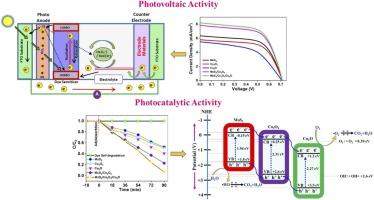Synergistic Effects in MoS2/Co3O4/Cu2O Nanocomposites for Superior Solar Cell and Photodegradation Efficiency
IF 5.8
2区 材料科学
Q2 CHEMISTRY, PHYSICAL
引用次数: 0
Abstract
Herein, we synthesized a Cu2O and Co3O4 incorporation with MoS2 to produce MoS2/Co3O4/Cu2O nanocomposites by facile sonication assisted hydrothermal methods. The phase structure and elemental composition of MoS2/Co3O4/Cu2O nanocomposites were investigated using X-ray diffraction (XRD) and X-ray photoelectron spectroscopy (XPS) techniques. Scanning electron microscopy (SEM) and transmission electron microscopy (TEM) morphology studies confirm that MoS2/Co3O4 nanostructure self-assembles in a mixed nanosheet configuration after the introduction of Cu2O. The synthesized samples were used as new types of Pt-free counter electrodes (CE) for DSSCs. Among all, the DSSCs based on the MoS2/Co3O4/Cu2O CE yields a maximum power conversion efficiency of 3.68% (Jsc = 8.2 mA cm-2, Voc = 0.71 mV and FF = 0.629%) under the standard AM 1.5 G illumination, which is 2.5 times higher than that of pure MoS2. To assess the photocatalytic activity, prepared samples were used to suppress methylene blue (MB) and rhodamine B (RhB) dye under UV-visible light irradiation. The MoS2/Co3O4/Cu2O nanocomposites had the highest photocatalytic degradation efficiency of all the samples. It increased degradation efficiency from 43% to 91% for MB dye after 100 minutes, and from 47% to 92% for RhB dye after 90 minutes. Scavengers test analysis proved that the superoxide radical (•O2-) play a major role in the MoS2/Co3O4/Cu2O photocatalytic system. After four consecutive photocatalytic cycles, the crystal structure and surface morphology of the MoS2/Co3O4/Cu2O nanocomposites used in the 4th cycle were more stable, and this was confirmed by SEM, EDAX and XRD studies. The broader significance of these findings provides a straightforward approach for synthesizing a low-cost and high-efficiency MoS2/Co3O4/Cu2O nanocomposite for CE in DSSC photovoltaic cells and facilitates organic pollutant removal through photocatalytic applications.

MoS2/Co3O4/Cu2O 纳米复合材料中的协同效应可提高太阳能电池和光降解效率
在此,我们采用简便的超声辅助水热法合成了一种将 Cu2O 和 Co3O4 与 MoS2 结合在一起的 MoS2/Co3O4/Cu2O 纳米复合材料。利用 X 射线衍射 (XRD) 和 X 射线光电子能谱 (XPS) 技术研究了 MoS2/Co3O4/Cu2O 纳米复合材料的相结构和元素组成。扫描电子显微镜(SEM)和透射电子显微镜(TEM)形态研究证实,引入 Cu2O 后,MoS2/Co3O4 纳米结构自组装成混合纳米片状构型。合成的样品被用作 DSSC 的新型无铂对电极(CE)。其中,基于 MoS2/Co3O4/Cu2O CE 的 DSSC 在标准 AM 1.5 G 光照下的最大功率转换效率为 3.68%(Jsc = 8.2 mA cm-2,Voc = 0.71 mV,FF = 0.629%),是纯 MoS2 的 2.5 倍。为了评估光催化活性,利用制备的样品在紫外可见光照射下抑制亚甲基蓝(MB)和罗丹明 B(RhB)染料。在所有样品中,MoS2/Co3O4/Cu2O 纳米复合材料的光催化降解效率最高。100 分钟后,MB 染料的降解效率从 43% 提高到 91%;90 分钟后,RhB 染料的降解效率从 47% 提高到 92%。清除剂测试分析证明,超氧自由基(-O2-)在 MoS2/Co3O4/Cu2O 光催化体系中起着主要作用。经过连续四个光催化循环后,第四个循环中使用的 MoS2/Co3O4/Cu2O 纳米复合材料的晶体结构和表面形貌更加稳定,这一点得到了 SEM、EDAX 和 XRD 研究的证实。这些发现的广泛意义在于为合成用于 DSSC 光伏电池中的 CE 的低成本、高效率 MoS2/Co3O4/Cu2O 纳米复合材料提供了一种直接的方法,并通过光催化应用促进了有机污染物的去除。
本文章由计算机程序翻译,如有差异,请以英文原文为准。
求助全文
约1分钟内获得全文
求助全文
来源期刊

Journal of Alloys and Compounds
工程技术-材料科学:综合
CiteScore
11.10
自引率
14.50%
发文量
5146
审稿时长
67 days
期刊介绍:
The Journal of Alloys and Compounds is intended to serve as an international medium for the publication of work on solid materials comprising compounds as well as alloys. Its great strength lies in the diversity of discipline which it encompasses, drawing together results from materials science, solid-state chemistry and physics.
 求助内容:
求助内容: 应助结果提醒方式:
应助结果提醒方式:


